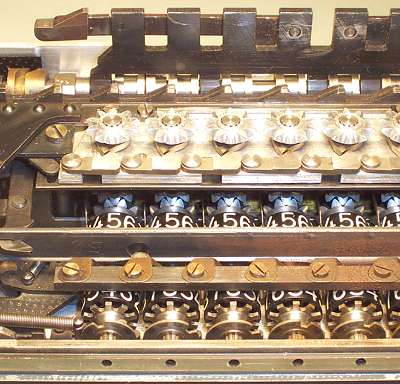 The carriage from underneath.
The carriage from underneath.
The "double carriage" on this machine has an additional 20-digit auxilliary register (Register IV) which can be coupled to the accumulator either in parallel or in reverse (to show complements). It has tens carry on the main counter register, and a second counter register with no carries. During re-assembly of the carriage I counted 1681 separate manufactured parts, but I may have missed a few... The carriage alone weighs just over 2.5kg (5.5lb).
 The carriage from underneath.
The carriage from underneath.
This illustration shows a general view of the carriage from underneath.
At the back is the carriage shift rack, with the Register IV camshaft immediately below. The "sawtooth" racks drive the clearance racks for the accumulator or result register (Register I) and the counter register (Register II). Below the clearance racks are the bevel pinions which engage with the differentials on the addition unit, and transfer the result to the Register I numeral wheels through the lower set of bevel gears. Just below the upper pinions are the cams or fingers which operate the carry sense levers, via the row of intermediate pawls.
At the front of the carriage are the numeral wheels for the counter register. These are driven via a ten-tooth star wheel, behind a solid shield disk with a single slot at the "nine" position. Detent springs are screwed to the bar above the numerals.
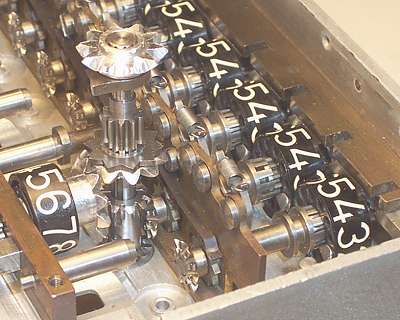 The Main and Auxilliary Registers (I and IV).
The Main and Auxilliary Registers (I and IV).
In this view the carriage is only partly assembled to show the arrangement of the Register I and IV gearing.
The main vertical shaft carries (from the top):
The differential gear drives Register IV either forward or reverse relative to Register I, or disconnects it in the neutral position.
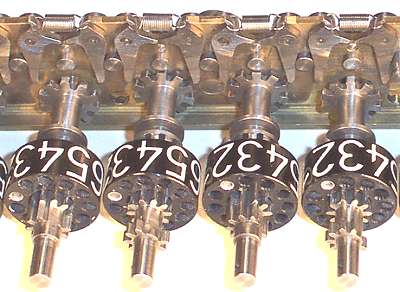 The Register IV Carry Mechanism.
The Register IV Carry Mechanism.
Because Register IV can be engaged and disengaged from Register I, it must be provided with its own carry mechanism. The mechanism is a miniature version of that described for the addition unit, but with an added complication.
In the addition unit, the carry mechanism operates on the transfer shafts, which always rotate in the same direction. Reversing is done afterwards, by the differentials. In the carriage, not only do the numerals rotate in either direction, but the sense of the carry must be also reversed depending on whether the register is set for normal or complement operation.
The illustration shows the essentials of the mechanism. A projection on the rear of the numeral wheels adjacent to digit 2 operates a carry sense finger, which pushes the next carry pinion rearward as the display passes from 9 to 0. The RIV camshaft raises an operating finger under one or other of the fingers to either side of the star wheel, depending on the setting of the carry reversing mechanism. The selected finger rotates the numeral one step in the corresponding direction, provided that the sliding pinion is pushed rearward. A second cam then resets the sense finger, moving the carry pinion forward and allowing the operating finger to reset without moving the numeral.
The Register IV operation is controlled by a camshaft across the full width of the carriage, which rotates in unison with the mainshaft. Supplying motive power to the moving carriage is accomplished through a long (140mm) "drum gear" across the back of the machine.
In the first 20° of rotation, the camshaft engages the RIV differentials according to the setting of the control lever and reversing mechanism on the right-hand end of the carriage. The addition unit advances the numerals between 20° and 180°, and the camshaft returns the RIV differentials to neutral from 180° to 200°. With Registers I and IV disconnected, the carry sequences can proceed independently. The addition unit completes its carry sequence across 10 digits as previously described, and the RIV camshaft completes a ripple carry across all 20 digits between 200° and 360°.
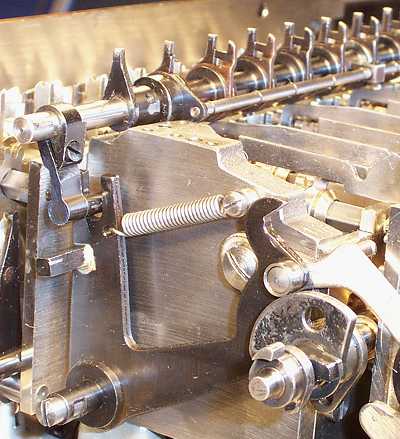 Register II Shaft and Rocking Mechanism.
Register II Shaft and Rocking Mechanism.
The shaft which operates the counter register (Register II) is located above the main add and carry mechanisms.
The "double" fingers are actually separate, with each front finger being firmly attached to the rear finger of the next stage, and spring-loaded against the previous stage in a cascaded fashion.
The fingers are clear of the carriage star wheels when the shaft is in the rest position, but are rocked backwards into engagement by the cam on the left-hand end of the mainshaft. The square pin and the hook on the cam follower connect to interlocks, eg to keep the shaft out of engagement during carriage shift cycles.
The single finger on the left-hand end of the shaft operates the left-hand half of the counter register, one digit at a time with no tens carry.
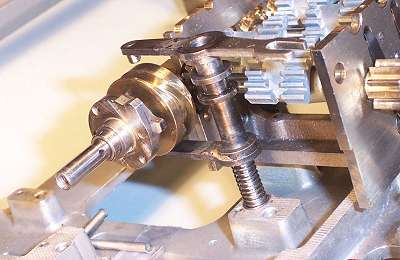 Register II Shaft Sliding Mechanism.
Register II Shaft Sliding Mechanism.
In addition to rocking fore-and-aft to engage with the star wheels, the counter operating shaft has to move side-to-side to advance the numbers. A peg clamped to the right-hand end of the shaft engages with this forked lever, which is driven side-to-side by the slotted cam on the mainshaft.
To reverse the direction of counting, the differential principle has been applied to the slotted cam. Raising or lowering the lever assembly will take the drive from either the top or bottom of the cam, thus reversing the phase of the sideways motion.
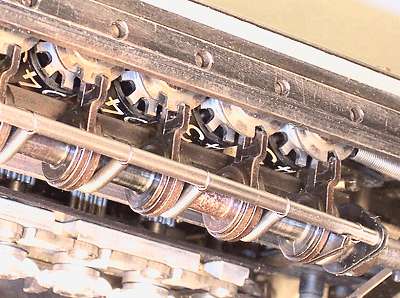 Register II Carry Operation.
Register II Carry Operation.
This view shows the counter register and its operating shaft, as it would appear looking up under the carriage from the front of the machine.
The two right-hand numerals stand at 9, the others at 0. As the shaft rotates inwards, the outer fingers on the right-hand numerals are able to move through the slots in the shield disks. Each outer finger connects to the inner finger on the next decade, so the inner fingers on decades 2 and 3 will engage with the star wheels. (The inner finger on the right-most decade always engages). When the shaft moves right-to-left, these three numerals will advance to 100.
The fingers on numerals that do not stand at 9 are blocked by their shield disks, or by the interlocking with previous decades, so that no further decades will be affected.